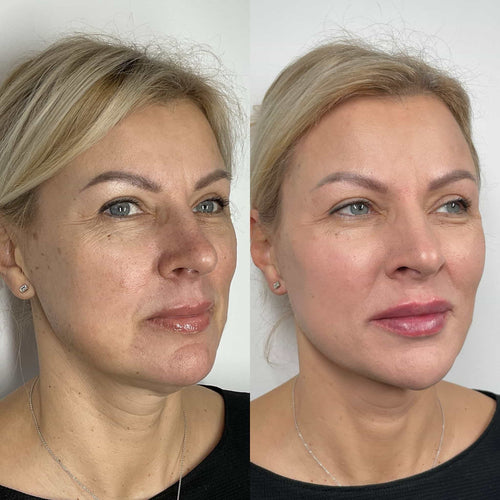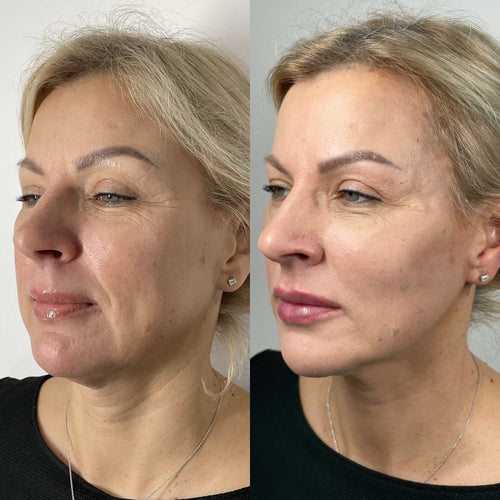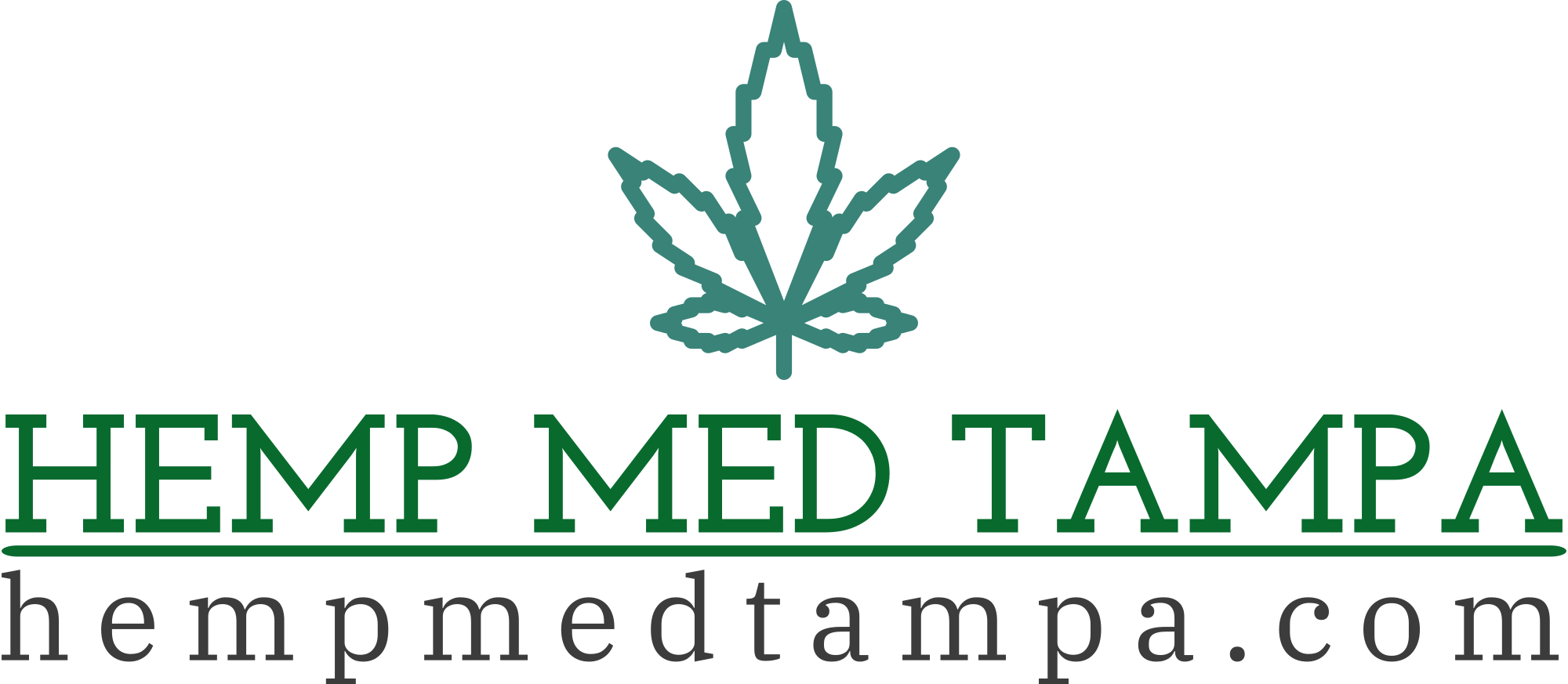Schedule a Dermal Filler Session with Dr. Laura Geige Now
Typical Swelling Timeline

Initial Puffiness
Initial swelling after lip filler injections typically peaks within 24-72 hours.
During this time, lips may appear noticeably plumper than intended as fluid accumulates around the injected area.
Most individuals experience significant reduction in swelling by day 3-5.
However, residual puffiness may persist for up to 1-2 weeks before completely subsiding.
Factors influencing the duration of swelling include:
- Amount of filler injected
- Individual’s metabolism and healing process
- Technique used by the injector
- Presence of any underlying skin conditions

While it’s common to experience initial puffiness, excessive or prolonged swelling could indicate an adverse reaction. If you notice persistent swelling beyond 2 weeks, contact your injector immediately.
Peak Swelling
Swelling after lip filler is a common side effect and generally subsides within a few days to weeks.
Here’s a typical timeline for swelling:
-
Immediately after the procedure: There will be noticeable swelling, redness, and bruising around the injection site.
-
Day 1-2:** Swelling peaks on the first day or two post-treatment.
-
Days 3-7: Swelling starts to decrease gradually, and the lips may still appear a bit swollen but more comfortable.
-
Week 1-2:** Most swelling resolves during this period. You’ll likely notice a significant reduction in inflammation and a clearer view of your final lip shape.
-
Weeks 2-4: Any remaining slight swelling should diminish further.
Factors influencing the duration of swelling include:
-
Amount of filler injected
-
Individual healing rate
-
Technique used by the injector
-
Any underlying medical conditions or medications being taken
It’s essential to follow your provider’s post-treatment instructions carefully to minimize swelling and optimize results. They may recommend applying ice packs, avoiding certain activities, and using prescribed medications.
Gradual Reduction
Swelling after lip filler injections is a common and normal reaction. The timeline for swelling reduction varies from person to person, depending on several factors including the amount of filler used, individual healing abilities, and post-injection care.
Here’s a general guideline of what to expect:
-
Immediate Post-Injection (0-24 hours): Expect noticeable swelling right after the procedure. This is due to the injection itself and the body’s immediate response.
-
First 2-3 Days: Swelling will peak within the first 24-48 hours. It may feel tight, tender, and your lips may appear significantly larger than intended.
-
Days 3-7: Swelling begins to gradually reduce. The majority of the initial swelling should subside by day 3 or 4.
-
Week 1: Most people experience a significant decrease in swelling by this point. Some minor residual swelling may remain, especially along the edges of the lips.
-
Weeks 2-4: Any remaining swelling should gradually diminish until it’s barely noticeable.
Remember that individual healing times can vary. It’s essential to follow your injector’s post-procedure instructions carefully to minimize swelling and promote optimal results.
Factors Influencing Swelling Duration
Injection Technique
Several factors influence the duration of swelling after lip filler injections.
One primary factor is the type and amount of filler used. Hyaluronic acid (HA) fillers, which are most commonly used, tend to cause more immediate and pronounced swelling compared to other types like calcium hydroxyapatite or poly-L-lactic acid.
The skill and experience of the injector also play a crucial role. Precise injection techniques that minimize trauma to surrounding tissue can lead to less swelling. Improper injection technique can cause bruising, bleeding, and significant inflammation, prolonging the swelling period.
Individual patient factors contribute significantly. People with sensitive skin or a history of allergies may experience more intense and prolonged swelling. Factors like age, skin thickness, and pre-existing medical conditions can also affect the body’s response to fillers and subsequent swelling.
Lifestyle choices also impact healing and swelling. Smoking, excessive alcohol consumption, and dehydration can hinder the body’s natural recovery process, leading to increased swelling duration.
Following post-treatment instructions carefully is essential for minimizing swelling. This includes avoiding strenuous activity, applying cold compresses, and elevating the head while sleeping.
Injection techniques greatly influence swelling.
Experienced injectors use a variety of techniques to minimize trauma and promote natural filler integration. These include:
• **Sub-dermal injection:** Injecting filler under the skin’s surface, which typically causes less swelling than superficial injection.
<
• **Fanning technique:** Spreading filler evenly beneath the dermis using multiple, fine injections, creating a more natural-looking result and reducing lumpiness and swelling.
• **Linear threading:** Injecting along specific lines to create volume and lift, minimizing the overall disruption of tissue.
Minimizing trauma during injection is paramount.
Sharp needles and proper cannula placement help reduce bruising and inflammation, leading to faster swelling resolution.
Filler Type
Swelling following lip filler injections is a common and expected side effect. The duration of swelling, however, can vary significantly depending on several factors.
One key factor influencing swelling duration is the type of filler used. Hyaluronic acid fillers tend to cause more immediate swelling that peaks within 24-48 hours and typically resolves completely within a week or so. Some patients may experience residual swelling for up to two weeks.
Conversely, collagen-based fillers often result in slower onset swelling that reaches its maximum intensity after a few days and gradually diminishes over the following weeks.
Another important factor is the amount of filler injected. Larger volumes generally lead to more pronounced and prolonged swelling.
Individual patient factors also play a role. People with sensitive skin or a history of allergic reactions may experience more significant or longer-lasting swelling. Certain medications, such as blood thinners, can also increase the risk of bruising and swelling.
Additionally, lifestyle habits like smoking, alcohol consumption, and sun exposure can exacerbate inflammation and prolong healing time, potentially extending swelling duration.
Proper aftercare is crucial for minimizing swelling and promoting optimal healing. Following your injector’s post-procedure instructions carefully is essential. This typically includes avoiding strenuous activity, applying ice packs to reduce inflammation, staying hydrated, and avoiding touching or massaging the treated area.
Individual Healing Response
Swelling after lip filler injections is a normal physiological response to any dermal injection. The duration of this swelling varies greatly from person to person, influenced by several factors.
One crucial factor is the volume and type of filler used. Larger volumes and certain types of fillers with a higher molecular weight may cause more pronounced and longer-lasting swelling.
Individual anatomical variations also play a role. Some individuals naturally tend to retain fluid more easily, leading to extended swelling periods compared to others.
Injection technique can also impact swelling. Experienced injectors who carefully place the filler precisely minimize trauma to surrounding tissues, potentially reducing swelling duration.
Lifestyle factors can influence healing and recovery. Smoking, alcohol consumption, and lack of sleep can hinder blood flow and impede the body’s natural healing processes, potentially prolonging swelling.
Pre-existing medical conditions like diabetes or autoimmune disorders can affect the body’s healing response and contribute to increased swelling duration.
Medications, particularly those affecting blood clotting or inflammation, may influence swelling. It is essential to disclose any medications, including over-the-counter drugs and supplements, to your injector.
Proper post-procedure care is paramount in managing swelling. Following the injector’s instructions regarding ice application, compression, and elevation can significantly reduce its duration and severity.
Finally, individual healing responses vary greatly. While some people experience minimal swelling that subsides within a few days, others may take up to two weeks or even longer for swelling to fully resolve.
It is crucial to remember that these are general guidelines. It’s best to consult with your injector to determine an expected recovery timeline specific to your individual circumstances.
Lifestyle and Habits
Swelling following lip filler injections is a common and typically temporary side effect. However, the duration of swelling can vary significantly from person to person.
Several factors influence how long swelling lasts after lip fillers:
- Type of Filler:** Different hyaluronic acid fillers have varying compositions and molecular weights. Some fillers tend to cause less swelling than others.
- Amount of Filler Injected: Larger injections typically result in more pronounced and longer-lasting swelling.
- Injection Technique: The depth and spread of injections can impact the amount of surrounding tissue affected, influencing swelling duration.
- Individual Healing Rate: People’s metabolisms and overall health play a role in how quickly their bodies process and remove injected material, affecting swelling resolution.
- Sun Exposure:** Sun exposure can increase inflammation and potentially prolong swelling.
Lifestyle and Habits:
- Smoking: Nicotine constricts blood vessels, which can impair healing and potentially increase swelling duration.
- Alcohol Consumption:** Alcohol can dehydrate the body, hindering tissue repair and possibly prolonging swelling.
- Exercise:** Moderate exercise can promote circulation and reduce swelling. However, intense workouts might exacerbate inflammation in the initial days after injection.
- Hydration: Staying well-hydrated is essential for overall healing and may help minimize swelling.
- Sleeping Position: Sleeping on your back or with your head elevated can potentially reduce morning swelling.
It’s important to note that while most swelling subsides within a few days, some residual puffiness might persist for up to two weeks. Following your injector’s post-treatment instructions carefully and practicing healthy lifestyle habits can help optimize healing and minimize any discomfort.
Minimizing and Managing Swelling
Ice Application
Minimizing and managing swelling after lip filler injections is crucial for achieving optimal results and a comfortable recovery.
Here’s a detailed guide on how to minimize and manage swelling, with a particular focus on ice application:
Understanding Swelling
Lip filler injections cause temporary inflammation as your body reacts to the foreign substance. This leads to localized swelling in the injected area. The severity of swelling varies depending on individual factors like the amount of filler used, injection technique, and personal sensitivity.
Immediate Post-Treatment Care
Follow these steps immediately after your lip filler treatment to minimize initial swelling:
- Ice Application: Apply ice packs wrapped in a thin towel to the treated area for 15-20 minutes at a time, with breaks of equal duration. Repeat this cycle for several hours after treatment. Ice helps constrict blood vessels and reduce inflammation.
- Compression: Gently pressing on the swollen area with a clean, cold compress can help minimize swelling.
- Avoid Touching or Rubbing: Resist the urge to touch or rub your lips excessively as it can irritate the injection sites and potentially worsen swelling.
Minimizing Swelling Over Time
Over the next few days, continue following these tips to manage ongoing swelling:
- Elevate Your Head: Sleeping with your head slightly elevated can help reduce fluid buildup in your face.
- Stay Hydrated: Drinking plenty of water helps flush out excess fluids and promote healing.
- Limit Alcohol and Caffeine: These substances can dehydrate the body and potentially exacerbate swelling.
When to Seek Medical Advice
While some swelling is normal after lip filler, seek medical attention if you experience any of the following:
- Severe or persistent swelling that doesn’t improve within a few days
- Signs of infection, such as redness, warmth, pain, or pus
- Difficulty breathing or swallowing
Schedule a Dermal Filler Appointment with Dr. Laura Geige Now
Reserve a Dermal Filler Consultation with Dr. Laura Geige Now
Elevation
Minimizing swelling after lip filler injections involves a combination of techniques and lifestyle choices aimed at reducing inflammation and promoting proper healing.
Elevating the treated area is one of the most effective strategies for minimizing swelling. Gravity can contribute to fluid buildup, so keeping your lips elevated above your heart helps encourage drainage.
Apply ice packs wrapped in a thin towel to the injected area for 15-20 minutes at a time, several times a day. This helps constrict blood vessels, reducing inflammation and swelling.
Avoid touching or rubbing the injected lips, as this can irritate the area and worsen swelling.
Refrain from strenuous activities that could increase blood flow to the face, potentially exacerbating swelling. Gentle walking is acceptable.
Stay hydrated by drinking plenty of water. Proper hydration supports the body’s natural healing processes.
Avoid alcohol and smoking, as these can dehydrate your body and hinder healing.
Follow your injector’s post-treatment instructions carefully, including any medications they recommend for pain or inflammation.
The duration of swelling varies from person to person, depending on factors like the amount of filler used, individual metabolism, and overall health. Generally, significant swelling subsides within 24-48 hours.
Some mild puffiness may persist for a few days or even a week before fully resolving.
Medications
Minimizing and managing swelling after lip filler injections is crucial for achieving optimal results and patient satisfaction.
Here are some effective strategies to minimize and manage swelling:
Cold Compresses:**
Applying cold compresses to the treated area for 15-20 minutes at a time, several times a day, can help reduce inflammation and constrict blood vessels.
**Elevation:**
Sleeping with your head elevated can promote fluid drainage and minimize swelling around the lips.
Hydration:
Drinking plenty of water helps flush out toxins and reduce inflammation.
Arnica Gel or Creams:**
Topical arnica gel or creams may have anti-inflammatory properties that can aid in reducing swelling.
Massage:
Gentle massage of the treated area can help improve blood circulation and lymphatic drainage, reducing swelling.
**Medications:**
Your doctor may recommend oral or topical medications to help manage swelling:
Nonsteroidal Anti-inflammatory Drugs (NSAIDs):**
Ibuprofen or naproxen can reduce inflammation and pain.
Antihistamines:**
In some cases, antihistamines may be prescribed to counteract any allergic reactions that could contribute to swelling.
It’s important to consult with your doctor before taking any medications, as they can advise on the appropriate dosage and potential side effects.
Avoiding Certain Activities
Minimizing and managing swelling after lip filler injections is crucial for achieving optimal results and a comfortable recovery.
Here’s a comprehensive guide on how to minimize and manage swelling:
-
Cold Compresses: Applying ice packs wrapped in a towel to the treated area for 10-15 minutes at a time, several times a day, can help constrict blood vessels and reduce inflammation.
-
Arnica Gel or Creams: Arnica is a natural anti-inflammatory herb that may help reduce swelling and bruising. Apply it topically to the treated area as directed on the product label.
-
Elevation: Keeping your head elevated while sleeping can help minimize fluid buildup in the face.
**Avoiding Certain Activities:**
-
Strenuous Exercise: Intense physical activity can increase blood flow and exacerbate swelling. Avoid strenuous exercise for at least 24-48 hours after your injection.
-
Excessive Sun Exposure: UV rays can irritate the skin and potentially worsen swelling. Protect your lips with a high SPF lip balm and avoid prolonged sun exposure in the days following your treatment.
-
Alcohol and Smoking: Alcohol and smoking can increase inflammation and hinder healing. It’s best to avoid these substances for at least 24 hours after your injection.
Remember, swelling is a normal part of the healing process after lip filler injections. However, by following these tips, you can help minimize its severity and promote faster recovery.
Tableau Consulting LLC Your Relationship Edge One One Three Online Line the Studio
- Why Does My Top Lip Stick Out After Filler - November 14, 2025
- What Is The Difference Between Lip Filler And Lip Flip - November 11, 2025
- What Are The Best CBD Gummy Sweets For Sleep Improvement - November 10, 2025
